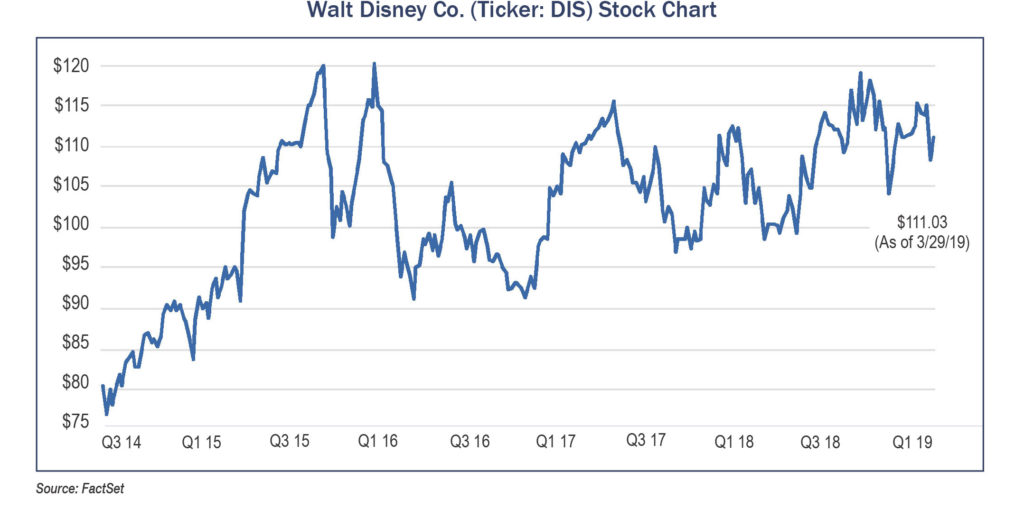Company Spotlight: Walt Disney Co (Ticker: DIS)
By Randy McMenamin, CFA
An informal survey asked people what is the first image they associate with the word Disney. The overwhelming response was Mickey Mouse. However, there is a lot more to Disney than the famous mouse. There is a new Disney on the horizon, brimming with major organizational changes.
Disney is a diversified worldwide entertainment company, which consists of four operating segments: Media Networks (41% of revenue), Parks and Resorts (34% of revenue), Studio Entertainment (17% of revenue), and Consumer Products & Interactive Media (8% of revenue).
The Media Networks segment includes cable and broadcast television networks, television production operations, domestic television and radio network stations. ESPN is Disney’s primary cable network. The company operates over 100 Disney branded television channels, which are broadcast in 34 languages and 164 countries/territories. These include Disney Channel, Disney Junior and Disney International HD. The broadcasting business includes a domestic broadcast network, television production and eight owned domestic television stations. Disney also owns ABC, a major TV network.
Parks and Resorts represents Disney’s most visible segment which features Walt Disney World Resort in Florida and Disneyland Park in California. The company expanded its theme park concept internationally and now operates venues in Paris, Hong Kong, Shanghai and Tokyo.
Studio Entertainment segment produces, distributes and acquires live-action and animated motion pictures, musical recordings and live stage plays. Familiar names include Walt Disney Pictures, Marvel, Lucas Film, Pixar and Touchstone. In addition, the company distributes the live-action films produced by DreamWorks Studios that were released from 2010 through 2016.
The new Disney involves the purchase of certain assets from 20th Century Fox (for about $85 billion) and the reorganization of the operating segment to Direct to Consumer and International (DTC). DTC is Disney’s number one priority. The company is focused on expanding content programming and technology to provide support for the success of the new segment. To provide additional content and programming, Disney recently completed its purchase of 21st Century Fox’s film and TV-entertainment assets with their rich vault of titles including “Modern Family,” “The Simpsons,” “Avatar,” and “Deadpool.” They also purchased FX, National Geographic Channels, Star India and Fox’s 30% stake in the streaming service Hulu. After the purchase, Disney will have a controlling interest in Hulu. The purchase of 21st Century Fox offers more appealing high-quality content and entertainment options to meet growing consumer demand, expand its international offerings and increase its direct-to-consumer content. This acquisition was all part of Disney’s plan to expand its streaming services.
In April, 2018, Disney launched ESPN+, a streaming service for sports fans, which currently has two million paid subscribers. ESPN+ operates on BAMTECH, acquired by Disney in 2017. This reliable streaming technology will also power Disney+, a video on demand service scheduled for late 2019.
The streaming business is becoming more competitive with current companies Netflix and Amazon. Now even AT&T is starting a streaming service. Presented with an over-abundance of choice, consumers look to brands they know to sort through the options and find what they want. Disney believes that their iconic brands will break through the competitive landscape and win over consumers.
Purchasing selected 21st Century Fox assets and BAMTECH were all designed to support and enhance the start of Disney’s new segment, Direct-to-Consumer (DTC). Disney’s other segments offer challenges and opportunities. Studio Entertainment ended 2018 with banner results including Star Wars: The Last Jedi, Thor: Ragnarok and Coco. Film offerings in the first half of 2019 are limited while the second half of 2019 offers promising releases from Marvel, Disney Animation, and Pixar Studios. These sales exceeded the lifetime domestic gross of Captain America: The Winter Soldier. International ticket sales exceeded $750 million, not necessarily a grand slam home run but still impressive. Parks and Resorts are expected to show continued strength with higher guest spending, more occupied room nights at hotels and increased attendance at most parks.
In the past, Disney made strategic acquisitions or expansions that supported a long-term view. Acquiring familiar film names or expanding their parks were decisions made for the continuing success of the company. Acquiring assets that expand their streaming services is another example of decisions designed to enhance future growth.
So where does all of this leave the company going forward? On the one hand, investors are right to note that some of Disney’s recent acquisitions stray far afield from cartoons, carnival rides and other areas of historical core competence. And yet, taking the long view, the case for the company’s more high-tech acquisitions is compelling. Increasingly, entertainment is just as much a matter of how content is consumed as what is being watched in the first place. In other words, Disney—all these years later—is operating with a shrewd eye to the future. To the delight of shareholders and seven-year-olds alike, it appears that the House of Mouse is here to stay.




